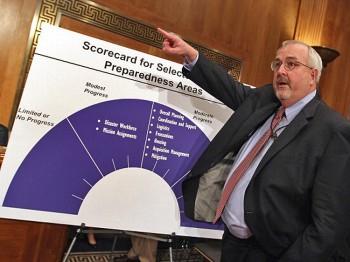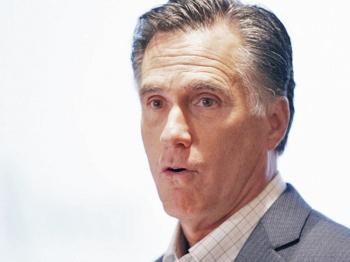BOSTON—On the day of this year’s summer solstice, Gov. Deval Patrick and his administration held several events throughout the state to mark the successes of the Bay State’s burgeoning solar energy sector, from a mere 3.5 megawatts (MW) at the start of his administration in 2007 to 51.5 MW of solar power installed today. This amount of renewable solar photovoltaic (PV) energy is equivalent to the annual electricity consumption of 8,145 households. The goal is another fivefold increase of solar power to 250 MW by 2017.
The growth of Massachusetts’s solar industry today was a result of the Patrick-Murray administration’s portfolio of forward thinking clean energy policies and programs, enacted by the administration and the Massachusetts Legislature. It jump-started the state’s solar industry from 30 companies involved in the manufacture, sale, and installation of solar power to approximately 200.
Employment in the state’s solar sector has also more than doubled. Without the dedication the Patrick-Murray administration has given, the increase in solar energy projects in the Commonwealth would not be possible. Massachusetts ranks No. 3 in its solar market in the country, behind California and New Jersey.
“As of today, solar panels across Massachusetts—at homes, schools, businesses, farms, industrial facilities, and more—are generating over 50 megawatts of clean, renewable energy, and we are on track to have over 90 megawatts installed or under contract by the end of this year,” said Energy and Environmental Affairs (EEA) Secretary Richard K. Sullivan Jr. in a press release. “In the process, we have added companies and jobs, and seen the cost of installing solar power cut in half. We have more work to do to reach the governor’s goal, but we clearly have much to celebrate.”
Massachusetts’s solar revolution was made possible through partnerships between the state administration, the Legislature, and the federal government through the American Recovery and Reinvestment Act (ARRA), and the private sector. While the ARRA provided most of the funding to large renewable energy projects through the Green Community Act, such as the 1.58 megawatt (MW) ground-mounted system at the Pittsfield Wastewater Treatment Plant, the Massachusetts Clean Energy Center (MassCEC) administers rebates and stimulus programs to support renewable solar PV projects to citizens, businesses, and institutions throughout the Commonwealth.
The state’s initial Commonwealth Solar program had $68 million of Massachusetts Energy Trust (MET) money in 2007 that became fully committed after only just 21 months. The state then rolled out Commonwealth Solar II that extended the rebate program; followed by $8 million of the federally funded Commonwealth Solar Stimulus program that helps business owners pay for some of the cost of a rooftop solar installation.
Massachusetts Renewable Energy Trust has been supported since 2003 by a charge on monthly electric bills.
MassCEC focuses on Solarize Massachusetts—a pilot program that reduces costs and boosts installation of solar power through a business model that leverages education, grass-roots marketing, and group purchasing to accelerate the adoption of solar PV.
Though solar PV installation has been successful in the state, it relies on rebates and subsidies to encourage people to adopt it. The cost of solar PV installation must come close to grid parity — approximately $.05–$.06 per kilowatt-hour (kWh) — for it to become broadly competitive without subsidies.
The U.S. Department of Energy’s (DOE) SunShot Initiative aims at reducing the total installed cost of solar energy systems by funding various R&D projects along the entire PV technology pipeline to arrive at a $1 per watt installed cost.
The DOE recently awarded $12.6 million to three Bay State solar companies: 1336 Technologies, Varian Semiconductor Equipment Associates, and Veeco Solar Equipment. The businesses will use the money for research and development to improve manufacturing and efficiency of solar panel modules.
In Lexington, 1336 Technologies Inc. won a conditional $150 million federal loan guarantee for establishing a silicon wafer processing method that can halve the cost of manufacturing. The company asserts its manufacturing process can dramatically cut the price of solar electricity down to about four cents per kilowatt-hour by 2020.
The MassCEC Catalyst Program has recently awarded $160,000 in grants to clean energy researchers at Boston University, MIT, and UMass-Dartmouth, which supports the commercialization of game-changing clean energy technologies coming out of Massachusetts’s world-class research institutions.
MIT researchers have recently discovered M13, a bacteria-eating virus that has the ability to bind to carbon nanotubes to keep it in place. At the same time, it can be genetically engineered to generate a layer of titanium dioxide, a key component in certain solar cells. This can increase the solar cell’s power conversion by 30 percent. This illustrated that inter-disciplinary interplay—in this case, between physics and biology—goes a long way.
The growth of Massachusetts’s solar industry today was a result of the Patrick-Murray administration’s portfolio of forward thinking clean energy policies and programs, enacted by the administration and the Massachusetts Legislature. It jump-started the state’s solar industry from 30 companies involved in the manufacture, sale, and installation of solar power to approximately 200.
Employment in the state’s solar sector has also more than doubled. Without the dedication the Patrick-Murray administration has given, the increase in solar energy projects in the Commonwealth would not be possible. Massachusetts ranks No. 3 in its solar market in the country, behind California and New Jersey.
“As of today, solar panels across Massachusetts—at homes, schools, businesses, farms, industrial facilities, and more—are generating over 50 megawatts of clean, renewable energy, and we are on track to have over 90 megawatts installed or under contract by the end of this year,” said Energy and Environmental Affairs (EEA) Secretary Richard K. Sullivan Jr. in a press release. “In the process, we have added companies and jobs, and seen the cost of installing solar power cut in half. We have more work to do to reach the governor’s goal, but we clearly have much to celebrate.”
Massachusetts’s solar revolution was made possible through partnerships between the state administration, the Legislature, and the federal government through the American Recovery and Reinvestment Act (ARRA), and the private sector. While the ARRA provided most of the funding to large renewable energy projects through the Green Community Act, such as the 1.58 megawatt (MW) ground-mounted system at the Pittsfield Wastewater Treatment Plant, the Massachusetts Clean Energy Center (MassCEC) administers rebates and stimulus programs to support renewable solar PV projects to citizens, businesses, and institutions throughout the Commonwealth.
The state’s initial Commonwealth Solar program had $68 million of Massachusetts Energy Trust (MET) money in 2007 that became fully committed after only just 21 months. The state then rolled out Commonwealth Solar II that extended the rebate program; followed by $8 million of the federally funded Commonwealth Solar Stimulus program that helps business owners pay for some of the cost of a rooftop solar installation.
Massachusetts Renewable Energy Trust has been supported since 2003 by a charge on monthly electric bills.
MassCEC focuses on Solarize Massachusetts—a pilot program that reduces costs and boosts installation of solar power through a business model that leverages education, grass-roots marketing, and group purchasing to accelerate the adoption of solar PV.
Though solar PV installation has been successful in the state, it relies on rebates and subsidies to encourage people to adopt it. The cost of solar PV installation must come close to grid parity — approximately $.05–$.06 per kilowatt-hour (kWh) — for it to become broadly competitive without subsidies.
The U.S. Department of Energy’s (DOE) SunShot Initiative aims at reducing the total installed cost of solar energy systems by funding various R&D projects along the entire PV technology pipeline to arrive at a $1 per watt installed cost.
The DOE recently awarded $12.6 million to three Bay State solar companies: 1336 Technologies, Varian Semiconductor Equipment Associates, and Veeco Solar Equipment. The businesses will use the money for research and development to improve manufacturing and efficiency of solar panel modules.
In Lexington, 1336 Technologies Inc. won a conditional $150 million federal loan guarantee for establishing a silicon wafer processing method that can halve the cost of manufacturing. The company asserts its manufacturing process can dramatically cut the price of solar electricity down to about four cents per kilowatt-hour by 2020.
The MassCEC Catalyst Program has recently awarded $160,000 in grants to clean energy researchers at Boston University, MIT, and UMass-Dartmouth, which supports the commercialization of game-changing clean energy technologies coming out of Massachusetts’s world-class research institutions.
MIT researchers have recently discovered M13, a bacteria-eating virus that has the ability to bind to carbon nanotubes to keep it in place. At the same time, it can be genetically engineered to generate a layer of titanium dioxide, a key component in certain solar cells. This can increase the solar cell’s power conversion by 30 percent. This illustrated that inter-disciplinary interplay—in this case, between physics and biology—goes a long way.



Friends Read Free